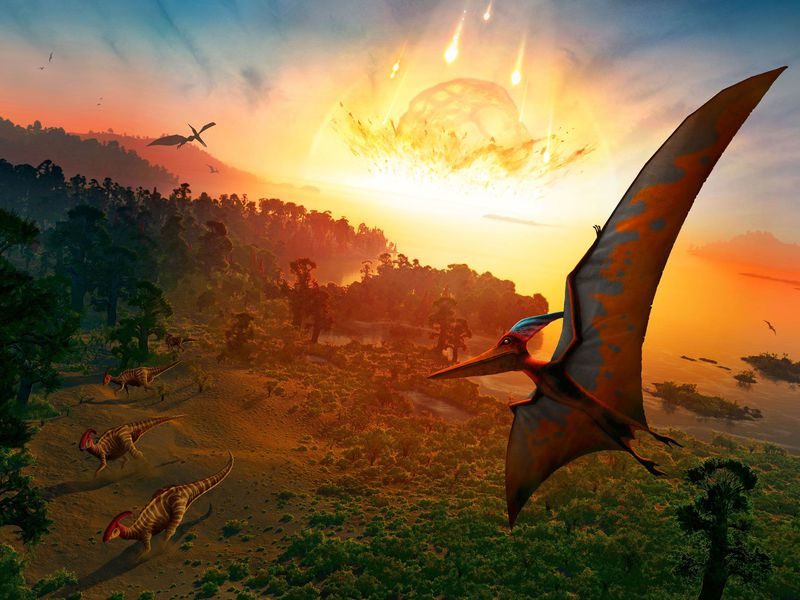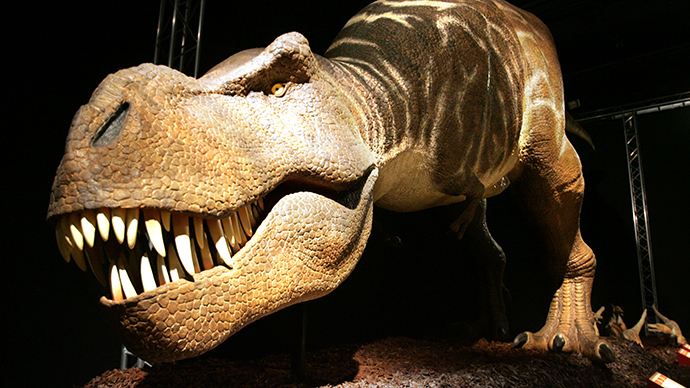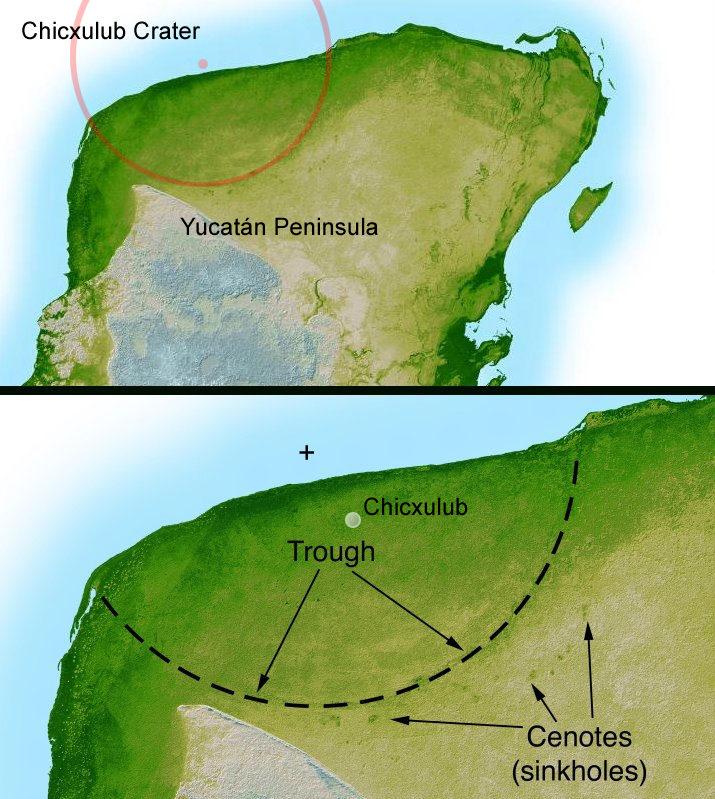
Paleontologists know this catastrophe as the K/Pg extinction event because it marks the transition from the Cretaceous into the Paleogene period of Earth's history. But even though it has been studied constantly, the details of this event still puzzle experts. The case wasn't closed with the recognition of the impact crater in the 1990s, and exactly how the extinction played out-what differentiated the living from the dead-continues to inspire paleontologists to dig into the cataclysm of the Cretaceous.
To better understand the full story, researchers are pulling back from the moment of impact to examine the broader patterns of life at the time. Dinosaurs were not living in a stable and lush Mesozoic utopia, nor were they the only organisms around at the time-far from it. The world was changing around them as it always had. As the Cretaceous drew to a close, sea levels were dropping, the climate was trending toward a cooler world, and a part of prehistoric India called the Deccan Traps was bubbling with intense volcanic activity. Sorting through how these changes affected life on Earth is no simple task, particularly after the cataclysmic meteorite mixed things up in the rock record, but paleontologists are sifting through the wreckage to better understand what happened.
"In order to get an idea of what happened in the wake of the asteroid impact, we need solid baseline data on what rates of background extinction were like before the K/Pg took place," Natural History Museum paleontologist Paul Barrett says. A moment of catastrophe can only make sense within the broader context of life before and after. "This would make the difference between the cataclysmic events at Chicxulub being either the primary cause of the extinction or merely the coup de grace that finished off an ecosystem whose resilience had been gradually worn away."
While the K/Pg extinction was a global crisis, how it played out at various locales around the planet is largely unknown. The amount of information at any given location depends on how well the relevant rock layers are preserved and how accessible they are to scientists. Some of the best exposures happen to be located in western North America, where there's a continuous sequence of sedimentary layers recording the end of the Cretaceous straight through to the beginning of the Paleogene. These rocks offer before and after shots of the extinction, and it's these exposures that has allowed Royal Saskatchewan Museum paleontologist Emily Bamforth to investigate what was happening in the 300,000 years leading up to the explosive close of the Cretaceous.
Looking at the geologic record of southwest Saskatchewan, Bamforth says, local conditions such as the frequency of forest fires and the characteristics of a particular habitat were as important as what was happening on a global scale when determining patterns of ancient biodiversity. "I think this is an important message to keep in mind when thinking of causes of the extinction," Bamforth says. "Each different ecosystem could have had its own smaller scale biodiversity drivers that were in operation before the extinction, which underlay the big, global factors." What was good for turtles, amphibians, plants, dinosaurs and other organisms in one place might not have been beneficial in another, underscoring that we can't comprehend global shifts without the foundation of local diversity. "Ecosystems are complicated things, and I think that is worth keeping in mind when considering the cause and duration of the mass extinction," Bamforth says.
As far as Saskatchewan goes, the ecological community at the time leading up to the extinction was like a big game of Jenga. "The tower remains standing, but factors like climate change are slowly pulling blocks out from it, weakening the system and making it vulnerable," Bamforth says. The constantly shifting ecological stability made major upsets-like an asteroid striking at the wrong place, at the wrong time-especially disastrous.
This picture of shifting ecosystems inverts the focus of the K/Pg disaster. While the reason non-avian dinosaurs and other organisms died off always grabs our attention, it's been harder for scientists to determine why the survivors were able to pass through to the next chapter of life's history.
Species that survived the impact were typically small, semi-aquatic or made burrows, and able to subsist on a variety of foods, but there are some key contradictions. There were some small non-avian dinosaurs that had these advantages and still went extinct, and many reptiles, birds and mammals died out despite belonging to broader groups that persisted. The badger-sized mammal Didelphodon didn't make it, for example, nor did the ancient bird Avisaurus, among others.
"This is something I struggle to explain," Barrett says. Generally speaking, smaller dinosaurs and other animals should have had better chances at survival than their larger relatives, but this was not always the case.

As far as the K/Pg extinction goes, the patterns are still emerging. Holroyd estimates that much of the relevant research about which species survived the impact has only been published or uploaded to the Paleobiology Database in the last decade. This new information allowed Holroyd and colleagues to study patterns of turnover-how long species persisted on land and in associated freshwater habitats-long before and after the asteroid impact. The team's findings were presented earlier this fall at the annual Society of Vertebrate Paleontology meeting in Albuquerque, New Mexico.
Some of the patterns were familiar. Fish, turtles, amphibians and crocodylians all generally fared better than strictly terrestrial organisms. "People have been observing this pattern since at least the 50s, and probably before," Holroyd says. But the resilience of waterbound species had never been quantified in detail before, and the new analysis is revealing that the solution to the extinction pattern puzzle may have been right in front of us all along.
The surprise, Holroyd found, was that the difference between the survivors and the extinct of the K/Pg event mimicked a pattern that has held true for tens of millions of years before and after the asteroid impact. Species living on land, particularly large species, tend not to persist as long as those living in freshwater environments. Terrestrial species often go extinct at a greater rate than those in aquatic environments even without a massive catastrophe to take them out of the picture. Species that lived in and around freshwater habitats appear to have persisted longer even when there wasn't a crisis, and when the extinction at the end of the Cretaceous struck in full force, these organisms had an advantage over their purely terrestrial neighbors.
But even in their relatively safe aquatic environments, everything wasn't peachy for water-faring animals. Holroyd notes that Cretaceous turtles, for example, lost fifty percent of their diversity globally, although only about twenty percent in the more localized area of western North America, further underscoring the importance of understanding local versus global patterns. Even lineages that can be considered "survivors" still suffered losses and may not have bounced back to their former glory. Marsupial mammals, for example, survived the mass extinction as a group but had their diversity and abundance drastically cut back.

"The western interior of North America gives us our only detailed window on what happened to life on land during the K/Pg extinction, but it's totally unclear if this was typical," Barrett says. "We don't know much about how the intensity of the extinction varied around the world," especially in locations that were geographically distant from the asteroid strike. "It seems unlikely that a one-size-fits-all model would be responsible" for cutting down organisms as different from each other as Edmontosaurus on land and coil-shelled ammonites in the seas, among so many other species lost to the Cretaceous. Research in Europe, South America, Asia and Australia is just beginning to form the basis of a much sought-after global picture of the most famous extinction event in history.
"It's like one gigantic jigsaw puzzle that we've started to turn up more of the pieces to," Bamforth says. The resulting picture of this critical moment in Earth's history will only be revealed in time.




Comment: An interesting post from MalagaBay may help highlight the key points involved when investigating extinction phenomena, as well providing a possible but as yet unacknowledged change in the environment that led to extinctions. And it may not be the only factor. You'll need to check out the full post for all the details but selected parts are quoted below: See also: